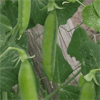The field of pea genetics received a boost today with the publication of a resource of pea mutants in Genome Biology.
The pea, Pisum sativum, is one of the most famous tools used in genetics: school children today learn that the 19th century monk Gregor Mendel studied the pea – for example, whether the seeds are wrinkled or not – and showed that this and other traits are inherited in a predictable way.
Peas have kept many of their other genetic clues secret, however, as they are unsuited to the genetic modification techniques that are commonly used to work with plants. Scientists, led by Abdelhafid Bendahmane, at the French National Agricultural research Institute (INRA) used an early flowering pea cultivar, called Caméor, to study mutant plants at different developmental stages (from seedling through to fruit maturation). The team studied DNA samples from 4,704 plants and identified many essential genes. From this they created a database called UTILLdb, which describes each mutant plant at each developmental stage studied, and incorporates digital images of the plants. UTILLdb contains phenotypic as well as sequence information on mutant genes, and can be searched plant traits of interest.
modification techniques that are commonly used to work with plants. Scientists, led by Abdelhafid Bendahmane, at the French National Agricultural research Institute (INRA) used an early flowering pea cultivar, called Caméor, to study mutant plants at different developmental stages (from seedling through to fruit maturation). The team studied DNA samples from 4,704 plants and identified many essential genes. From this they created a database called UTILLdb, which describes each mutant plant at each developmental stage studied, and incorporates digital images of the plants. UTILLdb contains phenotypic as well as sequence information on mutant genes, and can be searched plant traits of interest.
This new tool has implications for both basic science and for crop improvement, and the authors hope that it will fulfill the expectation of crop breeders and scientists who use the pea.
The full article was published today in Genome Biology and has received considerable attention in the media. The London Times features both a news item on the science, and a lead editorial celebrating the preeminent role of the humble pea in the progress of scientific understanding.
Ruth Rowland
Latest posts by Ruth Rowland (see all)
- A special series of companion papers from the FANTOM4 consortium - 20th April 2009
- The need for speed – making sense of the next generation of genome sequence data - 27th March 2009
- Genome Biology has a new look - 2nd October 2008
Comments